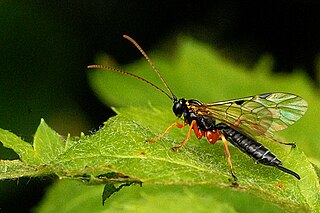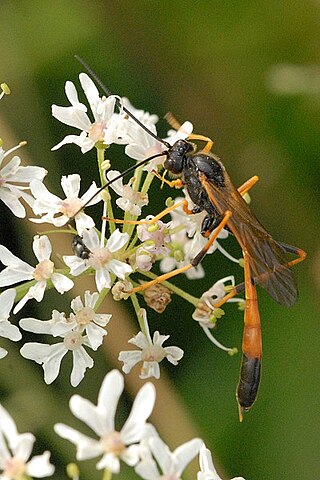
The superfamily Ichneumonoidea contains one extinct and three extant families, including the two largest families within Hymenoptera: Ichneumonidae and Braconidae. The group is thought to contain as many as 100,000 species, many of which have not yet been described. Like other parasitoid wasps, they were long placed in the "Parasitica", variously considered as an infraorder or an unranked clade, now known to be paraphyletic.

The Ichneumonidae, also known as ichneumon wasps, ichneumonid wasps, ichneumonids, or Darwin wasps, are a family of parasitoid wasps of the insect order Hymenoptera. They are one of the most diverse groups within the Hymenoptera with roughly 25,000 species described as of 2016. However, this likely represents less than a quarter of their true richness as reliable estimates are lacking, along with much of the most basic knowledge about their ecology, distribution, and evolution. It is estimated that there are more species in this family than there are species of birds and mammals combined. Ichneumonid wasps, with very few exceptions, attack the immature stages of holometabolous insects and spiders, eventually killing their hosts. They thus fulfill an important role as regulators of insect populations, both in natural and semi-natural systems, making them promising agents for biological control.

Cryptinae is a subfamily of wasps in the family Ichneumonidae. The family has also been called Gelinae, Hemitelinae, and Phygadeuontinae by various authorities, though the Phygadeuontinae have since been elevated to a separate subfamily.
Neopimpla is a genus of ichneumonid wasp. A junior synonym, Microceratops, was intermittently applied to a genus of ceratopsian dinosaur currently renamed as Microceratus.

Banchinae is a subfamily of ichneumonid parasitoid wasps containing about 1,500 species; the genera Glypta and Lissonota are very large. The three tribes are all distributed worldwide.

Xoridinae are a worldwide subfamily of the parasitic wasp family Ichneumonidae.

Pimplinae are a worldwide subfamily of the parasitic wasp family Ichneumonidae.

The Metopiinae are a worldwide subfamily of the parasitic wasp family Ichneumonidae. Metopiinae are koinobiont endoparasitoids of Lepidoptera. There are 26 extant genera. A bulging shield-like face is diagnostic for members of this subfamily, but many members lack this character.

Anomaloninae is a subfamily of parasitoid wasps in the family Ichneumonidae. Several species provide beneficial services to humans by attacking forest or orchard pests.

Ichneumoninae is a worldwide subfamily of the parasitic wasp family Ichneumonidae.

Campopleginae is a large subfamily of the parasitoid wasp family Ichneumonidae with a world-wide distribution. Species in this subfamily have been used in the biological control of the alfalfa weevil, clover weevil, various species of Heliothis, oriental army worm, European corn borer, larch sawfly, and others.

Mesochorinae is a worldwide subfamily of the parasitic wasp family Ichneumonidae.

The Labeninae is a subfamily within the parasitoid wasp family Ichneumonidae. The family is divided into 12 extant genera grouped within four tribes.
Labenopimplinae are an extinct subfamily of the parasitic wasp family Ichneumonidae. Labenopimplinae are known from the Cenomanian of the Russian Far East and Turonian of Orapa, Botswana. The subfamily includes five genera with 13 species. The subfamily is highly polymorphic and combines features of the Labeninae and Pimplinae.

Rhyssa persuasoria, also known as the sabre wasp, is a species belonging to the family Ichneumonidae subfamily Rhyssinae. Members of this subfamily, including those of Rhyssa and the allied Megarhyssa, are also known collectively as giant ichneumonid wasps or giant ichneumons.
Westwoodia is a genus of parasitoid wasps in the subfamily Ctenopelmatinae. A neotropical genus of butterflies was known as Westwoodia but is now referred to as Xenandra.

Megarhyssa macrurus, also known as the long-tailed giant ichneumonid wasp or long-tailed giant ichneumon wasp, is a species of large ichneumon wasp. It is a parasitoid, notable for its extremely long ovipositor which it uses to deposit an egg into a tunnel in dead wood bored by its host, the larva of a similarly large species of horntail.

Aptesini is a tribe of ichneumon wasps in the family Ichneumonidae. There are 24 described genera.

Netelia is a genus of ichneumonid wasps in the subfamily Tryphoninae. There are over 330 described species in Netelia grouped into 12 subgenera.
Westwoodiini is a tribe of parasitoid wasps in the subfamily Ctenopelmatinae.
















